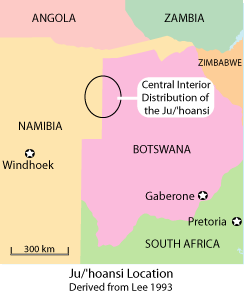The “helpers-at-the-nest” theory, at least a variant for humans, may apply to several agricultural societies but it does not hold true for the traditional Ju/’hoansi. The biological theory suggests that female animals of breeding age, such as some bird species, can pass along their genetic fitness just as effectively by assisting their parents—by acting as “helpers at the nest”—as by raising their own offspring. Several scholars have extended this theory to human societies, primarily agricultural ones, though with the interesting wrinkle that women whose first child is a daughter, or even whose first several children are females, have higher reproductive successes and their subsequent children live longer than if the first child is a male.
 A recent article by Raymond Hames and Patricia Draper carefully reviews the human helpers-at-the-nest literature as a preface to an explanation of their own research. The authors are skeptical that the theory would apply to a traditional hunting and gathering society such as the Ju/’hoansi of southern Africa because their economic conditions differ from that of agricultural peoples. Hames and Draper believe that the economic subsistence activities and the natural environment of a society are critical factors in determining whether children can be “helpers at the nest.” For instance, unlike the hunter-gather societies, in the agricultural societies fields are often fairly close to the homes so women can monitor the activities of their children while they work and children can be involved with their mothers.
A recent article by Raymond Hames and Patricia Draper carefully reviews the human helpers-at-the-nest literature as a preface to an explanation of their own research. The authors are skeptical that the theory would apply to a traditional hunting and gathering society such as the Ju/’hoansi of southern Africa because their economic conditions differ from that of agricultural peoples. Hames and Draper believe that the economic subsistence activities and the natural environment of a society are critical factors in determining whether children can be “helpers at the nest.” For instance, unlike the hunter-gather societies, in the agricultural societies fields are often fairly close to the homes so women can monitor the activities of their children while they work and children can be involved with their mothers.
In addition, in agricultural societies children are physically able to help while they are still young, between ages 7 and 12. They can handle light tasks that do not require adult strength, such as weeding and some harvesting, they can assist with some food processing work, and they can care for small animals. Furthermore, in many agricultural societies, girls are often likely to help with household duties, while boys begin hunting and fishing. Girls assist with the care of younger children much more frequently than do boys.
These conditions are very different from the traditional Ju/’hoansi culture, where children really could not provide much if any help with the food production. Women foraged for vegetables miles from the camp and it would have been nearly impossible for them to bring along their children and the water they might need for the day. While children might make tasty snacks for roving predators such as hyenas, leopards, cheetahs, and lions, the possibility of a child getting lost in the tall vegetation of the Kalahari Desert was an even greater worry for the parents.
To avoid these hassles, the Ju/’hoansi simply left their children in camp where some adults always remained. They would not go out foraging every day, so some adults were always around to reciprocate childcare duty. Interestingly, the older children who were also in the camp did not get involved in childcare—in their society, that remained the responsibility of adults only.
All of these factors, in the view of Hames and Draper, made it highly unlikely that the gender of the first several children would have any appreciable affect on the survival rate or breeding success of the mother. In order to test their hypothesis, that the helper-at-the-nest theory did not apply to the Ju/’hoansi and that the sex of the first child was irrelevant to the breeding success of the mother, the authors analyzed data obtained by Draper in 1987-88 and 1990 for an earlier research project. From her data, they selected interviews with 89 women over age 40—post-menopausal women who would have born most of their children while the Ju/’hoansi still subsisted in the traditional foraging mode.
The results of their statistical analysis of the data are that their hypothesis is correct. They found that for children aged 4 to 6, the sex of the first-born child did not relate to the mother’s subsequent fertility or the survival of her other children. They had similar results for children in the age groups 7 to 9 and 10 to 12.
The authors suggest that several issues may complicate their results. For one thing, in traditional Ju/’hoansi society girls often married while still quite young and they lived with the bride’s family for several years—a practice referred to as bride-service. As the young hunter learned to hunt and demonstrate his prowess as a provider, it is possible that the young married woman provided enough assistance to her own mother to contribute to the mother’s fertility and the survival rates of her youngest children.
The very fact of a mother producing children who survived may have demonstrated that she had better, healthier genes for child rearing or that she was a better caregiver. The authors suggest that while these other complicating factors may have existed, as interesting as the helpers-at-the-nest theory may be for other societies, it was not really valid for the traditional hunting and gathering Ju/’hoansi society.
Hames, Raymond and Patricia Draper. 2004. “Women’s Work, Child Care, and Helpers-at-the Nest in a Hunter-Gatherer Society.” Human Nature 15 (4):319-341. Also available on the web.